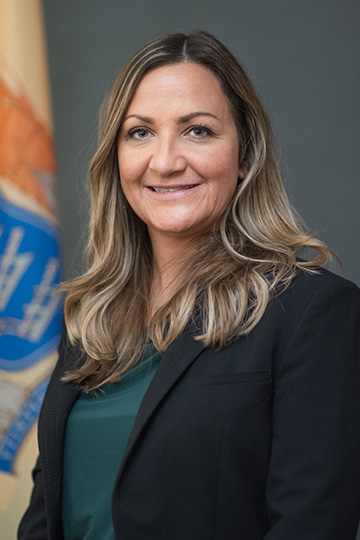
Responding to Emerging Contaminants: 1,4-Dioxane
The New Jersey Department of Environmental Protection is a national leader on addressing emerging chemical contaminants. New Jersey is committed to protecting our drinking water from chemical exposure risks of 1,4-dioxane. The DEP will continue to work together with our partners in the public and private sectors to address this issue.
About 1,4-Dioxane
1,4-dioxane is a synthetic chemical used as a solvent in products such as adhesives, resins, oils and waxes and wood pulping, and was formerly used as a stabilizer for chlorinated organic solvents. 1,4-dioxane is also used in the manufacture of pharmaceuticals, certain plastics and rubber, and other products.
The chemical also appears as a byproduct of surfactants used in personal care products, detergents and cosmetics. Significant exposure to 1,4-dioxane is not known to occur during showering or bathing, as the chemical is not absorbed through the skin and does not vaporize significantly into the air from drinking water. However, since scientific studies indicate that 1,4-dioxane may pose a threat to human health if ingested in sufficient amounts, the chemical is a concern for drinking water supplies.
Information on health effects of 1,4-dioxane comes primarily from studies of laboratory animals, which show that prolonged exposure to low levels of 1,4-dioxane may result in adverse health impacts. Research suggests lifelong exposure to 1,4-dioxane may be associated with an increased risk of cancer or damage to the kidneys or liver. The United States Environmental Protection Agency (EPA) has classified the chemical as “likely to be carcinogenic to humans” from long-term exposure.
In addition to its human health impacts, 1,4 dioxane is also harmful to natural resources. It is a recognized animal carcinogen, and has been shown to be taken up by fish, aquatic microorganisms, and other biota.
1,4-Dioxane and the Delaware River
DEP has organized an interstate working group to address the detection of the synthetic chemical, 1,4-dioxane, in the Delaware River. The working group consists of experts from DEP, the Pennsylvania Department of Environmental Protection, Delaware Department of Natural Resources and Environmental Control, and the Delaware River Basin Commission, as well as representatives from New Jersey American Water and other water system industry representatives. This working group collaboratively investigates potential sources of the chemical and possible remedies. This work includes enhanced sampling and assessment as well as sharing of data and information. As a potential source or sources are identified, the group works to coordinate a course of action to quickly address any potential risks to the environment or public health.
Regulating 1,4-Dioxane
Ground Water:
The NJDEP has adopted a Ground Water Quality Standard (GWQS) of 0.4 µg/L. Of an estimated State population of 8.9 million, about 3 million people rely on ground water from public water supply wells and private domestic potable wells. The ground water quality standard for 1,4-dioxane ensures that a current and scientifically based standard to protect, maintain, and restore ground water quality is in place. The ground water quality standards also establish minimum standards for the remediation of contaminated ground water.
Drinking Water:
There are no current federal or New Jersey drinking water standards for 1,4-dioxane. The New Jersey Drinking Water Quality Institute (DWQI), comprised of the state’s leading water quality experts, recommended a health-based drinking water Maximum Contaminant Level (MCL) of 0.33 µg/L, which was accepted by DEP in December 2021. Following this, the DEP has initiated the stakeholder engagement in anticipation of rulemaking to establish and implement an MCL for 1,4-dioxane.
Litigation
On March 23, 2023, DEP, along with the Division of Consumer Affairs and the Attorney General’s Office, filed a complaint in state court to address 1,4-dioxane contamination across the state. The complaint names manufacturers and distributors of 1,4-dioxane and seeks to hold them responsible for the cleanup and removal of the chemical as well as their role in damaging natural resources and the public health. The suit alleges both environmental and consumer fraud claims and seeks natural resource damages, punitive damages, and other damages and penalties.
Additional Resources
- 1,4-Dioxane in Drinking Water Facts
- 1,4-Dioxane in Drinking Water FAQs
- DWQI Draft Recommendation Reports
- ITRC Factsheets
- Agency for Toxic Substances and Disease Registry (ATSDR) Tox FAQs
- EPA Technical Fact Sheet 1,4-Dioxane
- EPA Integrated Risk Information System (IRIS)
- EPA TSCA Work Plan Chemical Problem Formulation and Initial Assessment
- Agency for Toxic Substances and Disease Registry (ATSDR) Tox FAQs fact sheets
- National Institute for Occupational Safety and Health (NIOSH). “Dioxane – NIOSH Pocket Guide to Chemical Hazards”
- Complaint
- AG Platkin, NJDEP, and Division of Consumer Affairs Announce 1,4-Dioxane Contamination Lawsuit (AG Release)















